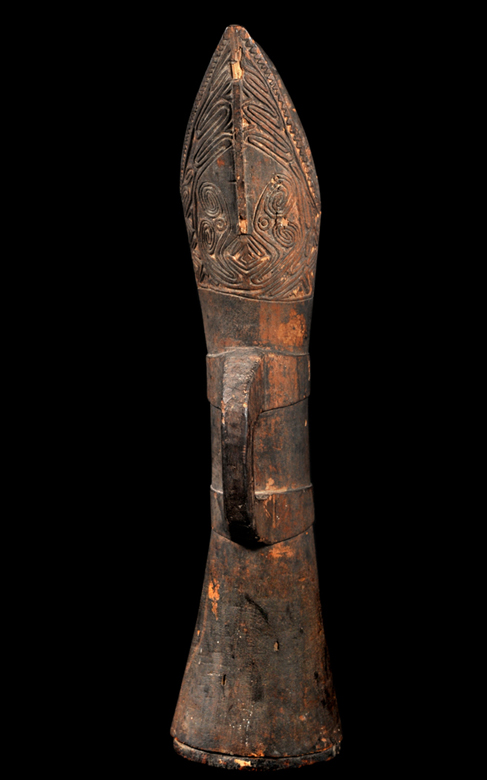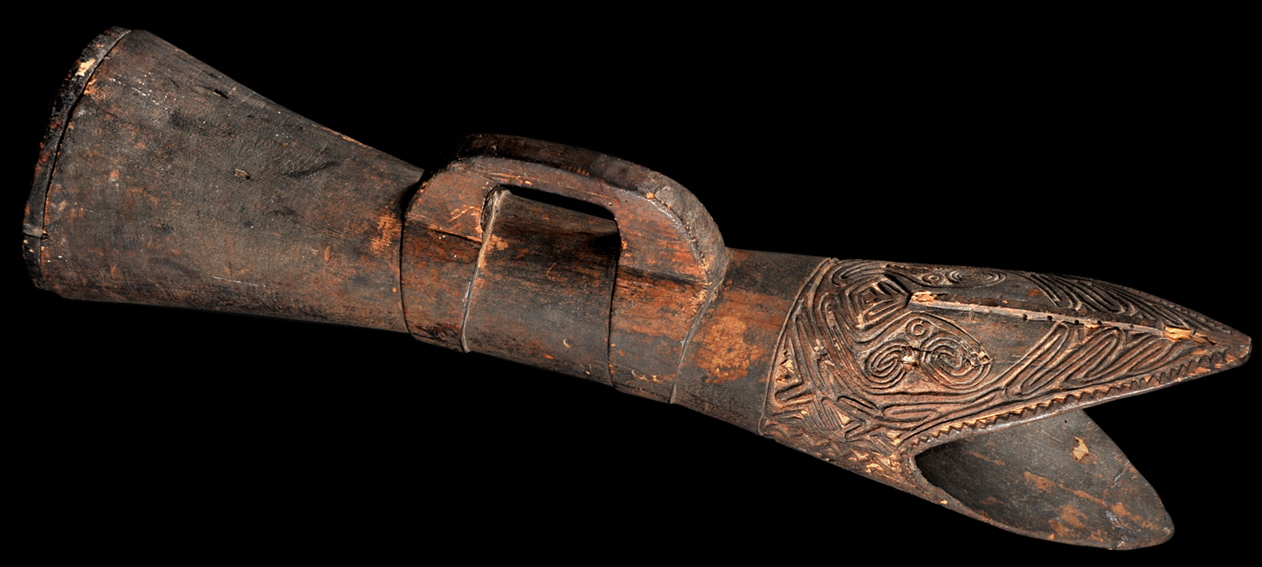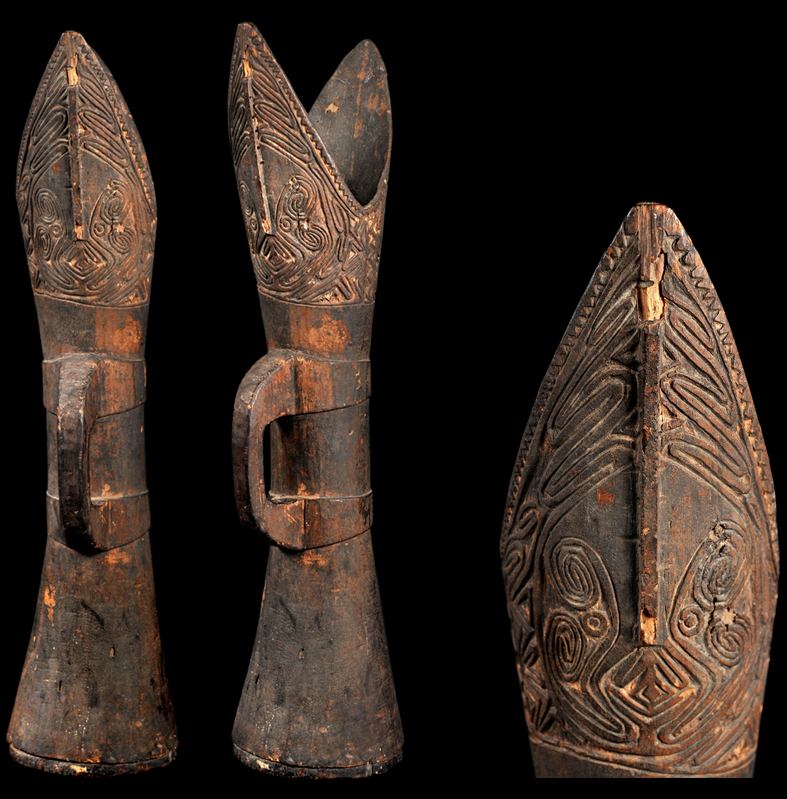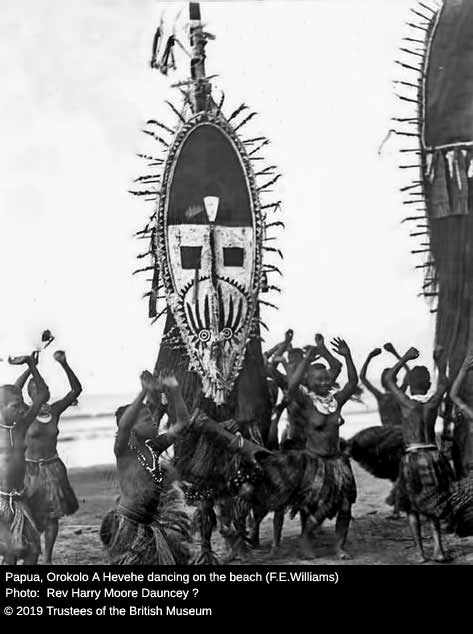DRUMS OF THE WORLD
New Guinea
Papuan Gulf drum New Guinea
Papuan Gulf drum probably Elema
Papuan Gulf drum decorated with ancestor faces. The open-mouth carving represents the concept of an instrument "speaking."
"Among the Orokolo, the masked hevehe dancers themselves played drums. While women were not allowed into the longhouses, upon emergence from the longhouse, each masked dancer was met by its own group of adoring females who danced with it in the village plaza and down to the beach over a period of a month. Such ceremonial cycles took between one and three decades to complete. Similar forms appeared among groups further to the east as well (Williams 1939:145, 152–55; 1940:357–58; Welsch 2006:11–12, 23)."
Excerpt from the book: Weiner, James F. and Niles, Don (2015); Songs of the Empty Place - The Memorial Poetry of the Foi of the Southern Highlands Province of Papua New Guinea.p.XXXVI
According to Robert Welsch, "Drums were emblazoned with clan emblems and imagery that represent particular spirits who look after human endeavors."
Das offene Ende dieser Trommel wird in der Literatur uneinheitlich als "Haimaul", "Fischmaul" oder "Krokodilmaul" bezeichnet.
Wahrscheinlich hat die zu einem Maul oder Rachen geformte untere Öffnung der Trommel einen Bezug zu der "pairama Initiations Ceremonie", bei der ein Kaiamunu oder Kopiravi genanntes, Menschen verschlingendes Urzeitwesen eine wichtige Rolle spielt.
Bibliography:
Weiner, James F. and Niles, Don (2015); Songs of the Empty Place - The Memorial Poetry of the Foi of the Southern Highlands Province of Papua New Guinea.
Williams, F.E.(1940) : Drama of Orokolo. The social and ceremonial life of the Elema.
Wirz, Paul : Beiträge zur Ethnographie des Papua-Golfes, Britisch-Neuguinea.
Welsch, Robert L., Webb, Virginia-Lee; Haraha, Sebastian (2006) : Coaxing the Spirits to Dance : Art And Society in the Papuan Gulf of New Guinea
Newton, Douglas (1961) : Art Styles of the Papuan Gulf, The Museum of Primitive Art, New York.
Hamson, M. (2010) : Red Eye of the Sun: The Art of the Papuan Gulf.
Lewis, A. B. (1925) : Decorative Art of New Guinea.
Chauvet, Stephen (1930) : Les arts indigènes en Nouvelle-Guinée.
Friede, J. (2005) : New Guinea Art - Masterpieces of the Jolika Collection from Marcia and John Friede.
Bell, Joshua A; Beran, Harry; Coupaye, Ludovic (2007) : Shadows of New Guinea - Art of the Great Island of Oceania in the Barbier-Mueller Collections.
Martinez-Jacquet, Elena; : Invocando a los espíritus : instrumentos musicales de Indonesia y Oceanía en la colección Helena Folch.
Barry Craig (Editor) (2011) : Living Spirits with Fixed Abodes - University of Hawai'i Press.
Kelm, Heinz (1966) : Kunst vom Sepik.
Papuan Gulf drum decorated with ancestor faces. The open-mouth carving represents the concept of an instrument "speaking."
"Among the Orokolo, the masked hevehe dancers themselves played drums. While women were not allowed into the longhouses, upon emergence from the longhouse, each masked dancer was met by its own group of adoring females who danced with it in the village plaza and down to the beach over a period of a month. Such ceremonial cycles took between one and three decades to complete. Similar forms appeared among groups further to the east as well (Williams 1939:145, 152–55; 1940:357–58; Welsch 2006:11–12, 23)."
Excerpt from the book: Weiner, James F. and Niles, Don (2015); Songs of the Empty Place - The Memorial Poetry of the Foi of the Southern Highlands Province of Papua New Guinea.p.XXXVI
According to Robert Welsch, "Drums were emblazoned with clan emblems and imagery that represent particular spirits who look after human endeavors."
Das offene Ende dieser Trommel wird in der Literatur uneinheitlich als "Haimaul", "Fischmaul" oder "Krokodilmaul" bezeichnet.
Wahrscheinlich hat die zu einem Maul oder Rachen geformte untere Öffnung der Trommel einen Bezug zu der "pairama Initiations Ceremonie", bei der ein Kaiamunu oder Kopiravi genanntes, Menschen verschlingendes Urzeitwesen eine wichtige Rolle spielt.
Bibliography:
Weiner, James F. and Niles, Don (2015); Songs of the Empty Place - The Memorial Poetry of the Foi of the Southern Highlands Province of Papua New Guinea.
Williams, F.E.(1940) : Drama of Orokolo. The social and ceremonial life of the Elema.
Wirz, Paul : Beiträge zur Ethnographie des Papua-Golfes, Britisch-Neuguinea.
Welsch, Robert L., Webb, Virginia-Lee; Haraha, Sebastian (2006) : Coaxing the Spirits to Dance : Art And Society in the Papuan Gulf of New Guinea
Newton, Douglas (1961) : Art Styles of the Papuan Gulf, The Museum of Primitive Art, New York.
Hamson, M. (2010) : Red Eye of the Sun: The Art of the Papuan Gulf.
Lewis, A. B. (1925) : Decorative Art of New Guinea.
Chauvet, Stephen (1930) : Les arts indigènes en Nouvelle-Guinée.
Friede, J. (2005) : New Guinea Art - Masterpieces of the Jolika Collection from Marcia and John Friede.
Bell, Joshua A; Beran, Harry; Coupaye, Ludovic (2007) : Shadows of New Guinea - Art of the Great Island of Oceania in the Barbier-Mueller Collections.
Martinez-Jacquet, Elena; : Invocando a los espíritus : instrumentos musicales de Indonesia y Oceanía en la colección Helena Folch.
Barry Craig (Editor) (2011) : Living Spirits with Fixed Abodes - University of Hawai'i Press.
Kelm, Heinz (1966) : Kunst vom Sepik.




